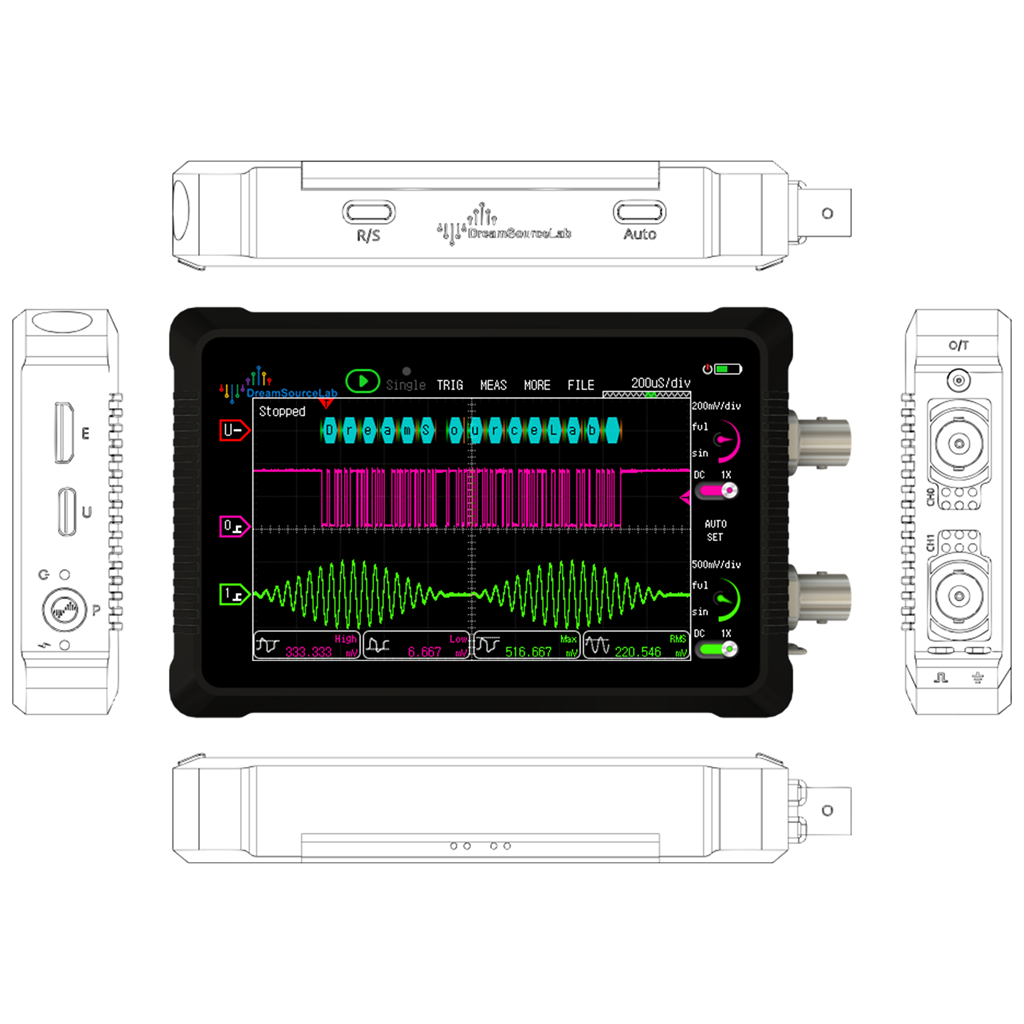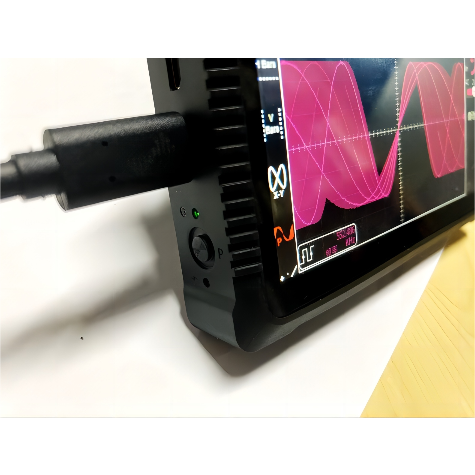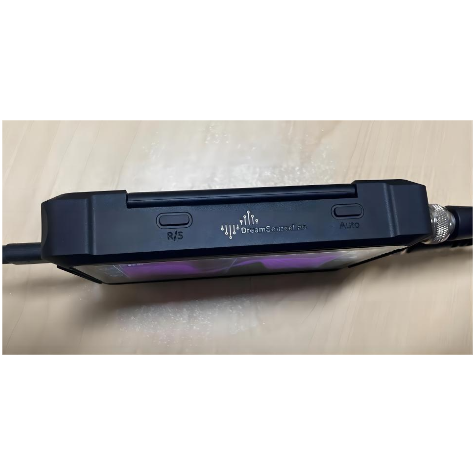Traditional desktop oscilloscopes meet our signal debugging needs. However, they have some drawbacks. For instance, they require AC power and have restricted measurement grounding, which can introduce safety hazards. They are also bulky, expensive, noisy, and their physical knobs and buttons are easily damaged. This makes them less accessible for entry-level users due to their high cost and learning threshold.
DSTouch maintains or exceeds the performance of desktop oscilloscopes while shrinking to palm-size (117x77x20mm). This makes it ultra-portable and convenient to carry and use anytime, anywhere. The lithium battery power supply design eliminates the constraints of cables and signal grounding, while the all-touch interaction makes it easy to operate. DSTouch also supports advanced features like FFT-based spectrum analysis and real-time protocol decoding, making it an ideal tool for signal analysis.
Ultra-portable Touchscreen Oscilloscope
powered by DreamSourceLab

Palm-sized?
Desktop Oscilloscope Performance?
Large Storage Depth?
Smooth Operation?
High Waveform Refresh Rate?
Durable Battery?
How DSTouch achieve the design goals?
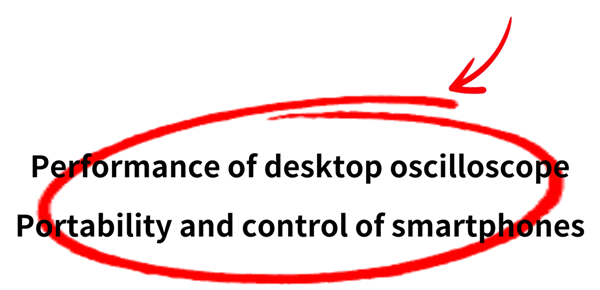
DSTouch has the same hardware architecture as desktop oscilloscopes,
with a powerful FPGA waveform processing engine and high-speed DRAM storage,
which is totally different from MCU-based solutions.

Compared with MCU-based solutions, DSTouch can achieve
Large Storage Depth and High Waveform Refresh Rate.

What are the differences between
MCU-based oscilloscopes and DSTouch

MCU-based oscilloscope

DSTouch oscilloscope
For a MCU-based oscilloscope (200MSa/s sample rate and a depth of 128K),
max acquisition time at 200MSa/s is only 0.5ms + 10Hz screen refresh rate.
The total waveform window time within 1 second is 0.5ms x 10 = 5ms.
DSTouch DS4T212 has a max acquisition time of 10ms at 200MSa/s
With a fixed 60Hz screen refresh rate
The total waveform window time within 1 second is 10ms x 60 = 600ms.

This kind of performance gap is difficult to discern simply from technical specifications,
leading to many mixed-quality products in the market.

Bandwidth refers to the signal frequency at which the amplitude response of the analog front-end circuit drops to -3dB for a sine wave.
Taking the example of the DS4T212, with a nominal bandwidth of 70M, when a sinusoidal sweep signal ranging from 0 to 100M is inputted, it can be observed that the entire frequency range is displayed correctly, with a smooth decrease in amplitude.

70MHz bandwidth DSTouch can still trigger and display 92MHz sine wave signal stably, but according to the -3dB calculation, its bandwidth is still only 70MHz.
DSTouch oscilloscopes mark the true real-time sampling rate, instead of confusing the audience with equivalent sampling rates.


Square wave is a good way to test the real-time sampling rate, and many low-end oscilloscopes cannot display high-frequency square waves correctly. DSTouch provides multiple interpolation methods to perfectly restore high-frequency square waves.

Storage depth is also an obstacle that low-end oscilloscopes cannot overcome, and it is one of the three most important indicators of oscilloscopes, which seriously affects the actual waveform restoration effect.

How to confirm the real storage depth of an oscilloscope? This can be tested using an amplitude-modulated signal with a high carrier frequency (low-frequency envelope, high-frequency carrier). Only oscilloscopes with a sufficient storage depth can correctly capture both the envelope and the high-frequency carrier.
Below is a test using a 300Hz amplitude-modulated 10M carrier signal.
You can use this signal to verify the storage depth specification of your oscilloscope.
Oscilloscopes with insufficient storage depth will not be able to capture such signals.

DS4T212 perfectly captures 300Hz amplitude modulated 10M sine wave signal.
The low-end version of the DSTouch oscilloscope has a storage depth of up to 2Mpts, which is even larger than the depth of some desktop oscilloscopes. And it maintains the same storage depth at full horizontal resolution.

Perfectly restore the internal high-frequency signal
The signal captured by DSTouch oscilloscope can be zoomed in or out horizontally after stopping, perfectly reproducing the desired waveform.
DSTouch uses EPSON high-precision low-temperature drift crystal oscillator and hardware real-time frequency measurement.

A oscilloscope that cannot measure millivolt-level signals is a toy, not a tool.

*DC/DC Power Ripple Analysis
DSTouch can be used to measure tiny signals at the millivolt level, supporting 20MHz bandwidth limitation, is the best tool for power ripple analysis.

DSTouch has a minimum vertical sensitivity of 1mv/div, and excellent low noise performance.

DSTouch has good input protection, with a voltage input range of up to ±200V.
DSTouch oscilloscope is designed with a complete set of “single-finger touch” operation methods, where all functions are simplified into 1-3 steps of tapping and sliding, without the need to search for buttons and menus everywhere.

Tapping twice allows you to add/delete a measurement option. There are 20 automatic measurement options available.

The horizontal resolution can be adjusted by sliding a single finger across the entire waveform area, while the scroll wheel area supports dragging for quick adjustment.

Rich channel control options are provided in the vertical direction, with scroll wheel adjustment and support for quick adjustment by dragging.
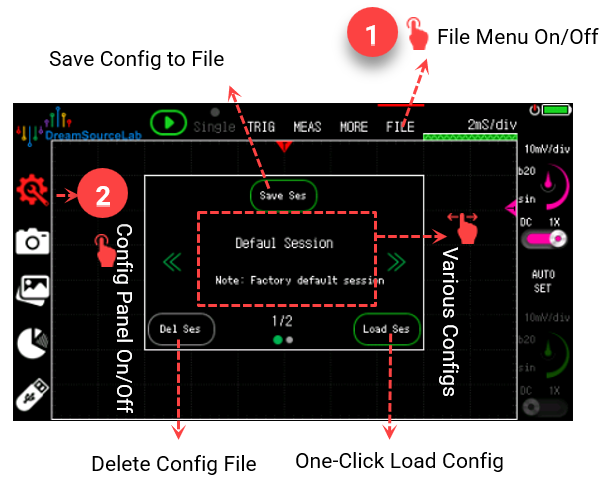
DSTouch supports storage and loading of up to 9 different configurations, allowing for one-click switching between configurations for different measurement scenarios.

Protocol decoder

FFT-based spectrum analysis

X-axis/Y-axis cursor.

Lissajous figure in X-Y mode.

Persistence display.

Signal generator.
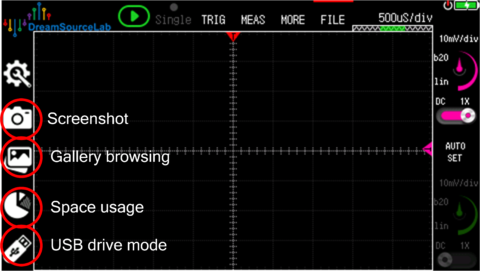
File function.

high-performance oscilloscope that can truly fit in your pocket

Seamless integrated soft rubber wrapping + hard plastic support shell design, with raised corners for anti-collision protection

Anti-wear protection strip for the front screen

Built-in bracket design, supports different angle supports

Fanless design, rejecting noise, for quiet thinking

3-6 hours of battery life, supports idle sleep mode


